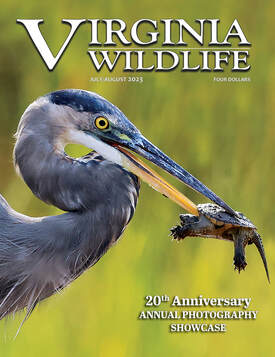In Memoriam
We remember two excellent naturalists and volunteers who have passed away this fall and will be very much missed.
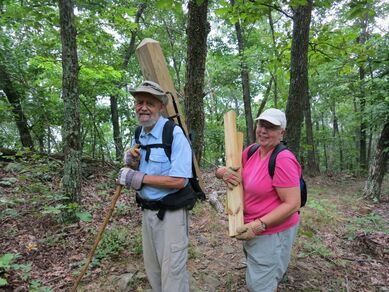 Guy Buford (left) volunteering for a stewardship project at Grassy Hill Natural Area Preserve. Photo by Rich Brager.
Guy Buford (left) volunteering for a stewardship project at Grassy Hill Natural Area Preserve. Photo by Rich Brager.
Guy Buford helped start VMN’s Blue Ridge Foothills and Lakes Chapter in 2007 and was a beloved, active member of and instructor for the chapter for more than a decade. Among his many lifelong accomplishments was helping to build some segments of the Appalachian Trail in the 1950s. Guy was still contributing VMN volunteer service in his late 80s, monitoring water quality at Booker T. Washington National Monument and tracking precipitation for the Community Collaborative Rain, Hail, and Snow Network.
Read more about Guy’s life in this obituary.
Thank you to Rich Brager for sharing photos and stories about Guy!
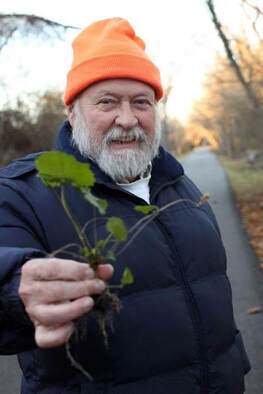 John Ford, VMN New River Valley Chapter member and VMN Golden Circle volunteer.
John Ford, VMN New River Valley Chapter member and VMN Golden Circle volunteer.
John Ford was one of the VMN New River Valley Chapter’s “super” volunteers, and he was a member of the VMN Golden Circle, a group of volunteers who have completed more than 5,000 hours of service. John was a plant enthusiast, and for years he volunteered 20 hours a week in the Virginia Tech Massey Herbarium, where he helped digitize the collection. To honor John, the New River Valley Chapter planted an oak tree in the Virginia Tech Old Growth Forest commonly known as Stadium Woods. The tree was cultivated from an acorn by Virginia Tech professor Dr. John Seiler from one of the ancient white oak trees at the site. In addition, the chapter has established an Annual John Ford Memorial Invasive Plant Removal Day at the forest for the third Sunday of each October. What a great way to honor a VMN volunteer — with a service event!
Thank you to Rebekah Paulson and Sandy Weber for sharing photos and stories about John!
 Micron Semiconductor employees participated in a VMN-led corporate volunteering day at Sky Meadows State Park.
Micron Semiconductor employees participated in a VMN-led corporate volunteering day at Sky Meadows State Park.
Corporate Volunteering at Sensory Explorers’ Trail
–By Sue Bailey, VMN Shenandoah Chapter
Originally appeared in the Shenandoah Chapter’s newsletter, the Shenandoah Saw-whet
One of our chapter’s remarkable initiatives is the Sensory Explorers’ Trail (SET) at Sky Meadows State Park.
“The trail provides visitors a way to engage their senses in the exploration of the natural world. In addition, it has special adaptations for the visually, hearing, and mobility impaired visitors. The trail offers .3 miles of discovery with eight stops along the way to guide visitors so that they can enjoy the sights, sounds, smells, and textures of the environment.”
After volunteering on the SET, a couple of years ago, I wondered if this might be volunteer opportunity for a newly formed group at my employer, Micron Semiconductor. The Micron employee group is called Capable. Its vision is to foster a workplace where seen and unseen disabilities are embraced. So, I approached Laure Wallace about the Capable team helping with the SET & VMN and she embraced it. In working with Laure, MK Ruffner & Ed Tobias, a plan was developed to have the Micron Capable team assist with the removal of invasive species along the trail in April 2022.
The 2022 event was such a success that it was held again this past April. The word success does not capture the true essence of this event. Yes, a lot of invasive plants such as garlic mustard, Japanese stiltgrass, and barberry were removed. Yes, the event drew the largest number of volunteers for any Micron Capable team community volunteer event. These are great but, what is most incredible is that the VMN team also created a truly amazing learning event, sparked interest in native plants & the natural world, and fostered a strong desire to be a part of something bigger than us!
I can’t begin to explain the number of times that Micron volunteers have expressed their appreciation of the event, Sky Meadows State Park, and the VMN team for their knowledge, their time, and their excitement about the ecosystem. Team members continue to stop me in the hallway to ask questions about nature; to note that they are now researching & planting native plants; to share a cool sighting; to mention they saw a butterfly (which triggered their memory of MK showing them a pawpaw tree & teaching them that the tree is host for the zebra swallowtail butterfly); or, to recall a other memories such as the number of jack-in-the-pulpits or, filling the back of Laure’s car full of “weeds” (garlic mustard). This is inspiring to me, and I want to express my thanks again to Laure, MK, Ed, Bill Moore, Rob Williams, Erin Clark, and Sky Meadows State Park for all their
efforts and for making such a positive difference. In my mind, this is what being a Virginia Master Naturalist is all about!
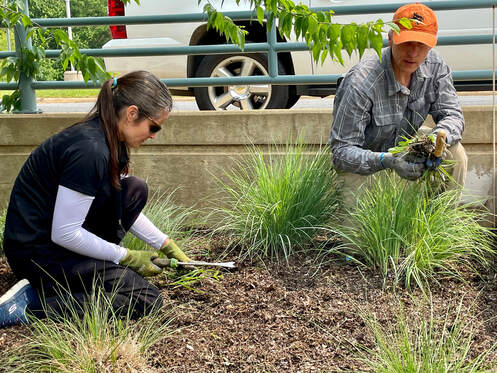 Joe Gorney and colleague Carley Aubrey working at Herrity Center. Photo courtesy of Joe Gorney
Joe Gorney and colleague Carley Aubrey working at Herrity Center. Photo courtesy of Joe Gorney
Fairfax Master Naturalist Recognized for Environmental Excellence
–Contributed by Jerry Nissley
On September 13th, the Fairfax County Office of Environmental and Energy Coordination (OEEC) announced the recipients of the 2023 Environmental Excellence Awards. This year’s winners include a high school senior working on environmental stewardship, a small business reducing waste, a condo association safeguarding green spaces for its residents, and three county employees advancing sustainability practices. Joe Gorney, VMN volunteer in the Fairfax Chapter, was one of the three winners in the County Employee Category.
Joe’s award profile stated that he is a Planner with the Department of Planning and Development, Environment and Development Review Branch. He works collaboratively with other county agencies on a diverse range of environmental review topics, working to create a sustainable future for residents and employees. He was the staff lead for the Environmental Plan guidance update for the Reston planning study, designating Reston as “biophilic” community.
Joe is a Fairfax Chapter past President and currently teaches the “Personal Stewardship for the Land” module for FMN Basic Training Cohorts. He was part of a team that monitored 36 bluebird boxes at Twin Lakes for several years. He also helped establish the golf course as an Invasive Management Area (IMA) site and has now transitioned to IMA site leadership duties.
In 2023 he has already volunteered over 40 hours in several categories. In addition to the IMA site leadership role at Twin Lakes, he has been busy designing a couple of native plantings at the Fairfax County Government Center (GC). He said, “We’ve already removed invasives around the GC Memorial area, which is an ongoing management process, and planted the area with natives. We’re also investigating planting 48 native trees around the GC Ellipse, which may happen in mid-October. I’m also inventorying landscape invasives around the GC, which are to be removed and replaced with natives, and designing other native tree plantings to the east of the GC. In addition to invasive pulls at the GC Memorial area, I’ve helped organize and participate in invasive pulls at the Herrity Building.” Joe also found time to be active on Audubon Home Ambassador projects and support FMN board with occasional admin duties.
Please join FMN in congratulating Joe on his well earned 2023 Environmental Excellence Award.
 Victoria Fortuna. Photo by Carolyn Smith.
Victoria Fortuna. Photo by Carolyn Smith.
Victoria Fortuna – Project Leader Extraordinaire
–Contributed by Charlene Uhl, VMN Old Rag Chapter
Victoria Fortuna demonstrates her twin passion for birds and butterflies as coordinator for two of Old Rag’s projects. Each summer since 2011 she has been responsible for ORMN’s participation in the North America Butterfly Association (NABA) butterfly count and each winter she has guided our chapter’s volunteers in collecting data for the Audubon Christmas Bird Count.
If you have not yet coordinated or administered a major project like these two, you may not fully appreciate the time, thought, creativity, commitment and challenges involved. The butterfly count requires recruitment of volunteers for the all-day event; scheduling experienced counters to train new participants; and establishing collection protocols for prompt reporting to NABA. This last summer ORMN fielded 52 volunteers to identify butterflies. Victoria devoted nearly 50 hours of volunteer time on this project to ensure a successful and accurate count.
For the Audubon bird count, Victoria recruited leaders and volunteers; compiled data over multiple locations; and reported to Audubon on the 71 different species observed. Over 80 hours of Victoria’s volunteer time is testament to her personal investment in the success of this project.
As Victoria plans to hand off the NABA Butterfly Count responsibilities to another ORMN member, we want to recognize and celebrate all she has done for butterflies, birds, and our Virginia Master Naturalist chapter.
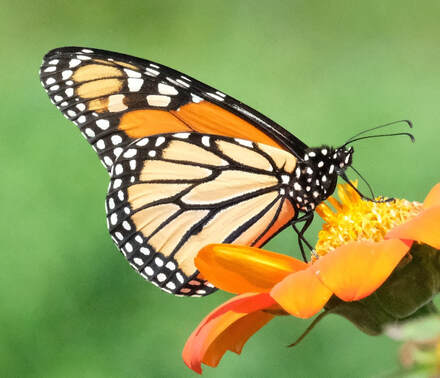
Monarch butterfly. Photo by Bill Bynum.
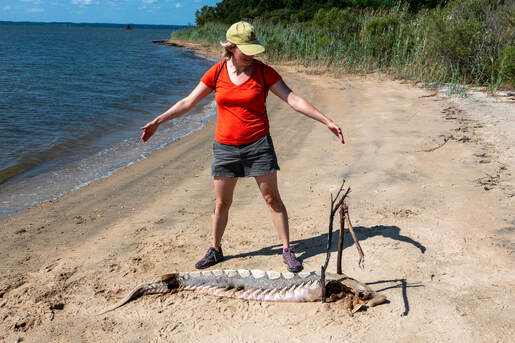 Volunteers found a tagged sturgeon at College Creek Beach during a litter cleanup. Photo by Jeanette Navia.
Volunteers found a tagged sturgeon at College Creek Beach during a litter cleanup. Photo by Jeanette Navia.
Unexpected Salvage Find at Litter Pickup Activity
–Contributed by Connie Reitz, VMN Historic Rivers Chapter
Several Historic Rivers Chapter members participated in a litter pickup activity at College Creek Beach on the National Park Service Colonial Parkway on August 23rd. The activity started normally with members enjoying the sun, sand, and a gentle breeze as they worked. Then things changed.
A visitor at the beach shared information regarding a large dead fish farther ahead on the beach. This intrigued the master naturalists and caused them to temporarily become distracted from litter pickup. The carcass of a beautiful Atlantic sturgeon (Acipenser oxyrinchus oxyrinchus) was found. One HRC member knew research was being done on this federally endangered species and needed to be reported. A photo, longitude & latitude coordinates, and detailed directions were sent to Matthew Balazik of the VCU Rice Rivers Center. Sticks were used to secure the fish until it could be retrieved. Then it was time to continue litter pickup.
Later members of HRC discovered the following post on the James River Sturgeon Facebook page.
“Well, today we salvaged our first James sturgeon that had a telemetry tag. We responded to a carcass and when it was pulled on shore the telemetry tag fell out on the beach. The fish was tagged 10 years ago tomorrow. It’s amazing because the tag battery is supposed to die after 10 years, which is tomorrow. I also remember this fish because someone took a fin ray sample long before we caught him in 2013 so he had a unique nub and still does today. He gave us a lot of great data over the past decade. A MASSIVE THANK YOU to the Historic Rivers Chapter of the Virginia Master Naturalist!! They found the fish while doing a beach cleanup (another great deed) and provided great directions so we could easily get the fish from a hard to reach area.”
No medals were draped around necks and no certificates were handed out. However, HRC members helped another agency with research. Working together is a win for everyone.
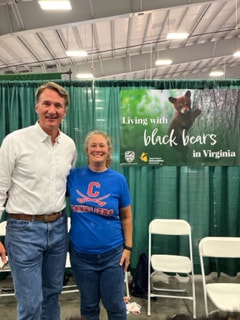 Governor Glenn Youngkin stopped by to the Riverine Master Naturalist booth at the Virginia State Fair to learn about black bears. Photo contributed by Sheila Barnett.
Governor Glenn Youngkin stopped by to the Riverine Master Naturalist booth at the Virginia State Fair to learn about black bears. Photo contributed by Sheila Barnett.
Living With Bears Goes to the Fair
Virginia Master Naturalists continue to educate the public about Living with Black Bears in partnership with the Virginia Department of Wildlife Resources. After receiving specialized training, the volunteers give talks and conduct outreach designed to inform community members about bear biology and about behaviors they can adopt that will reduce bear-human conflicts. These include behaviors such as securing trash cans, taking down bird feeders at certain times of year, and not leaving pet food outdoors.
As part of their outreach in this project, Riverine Master Naturalists have been staffing a Living with Black Bears booth at the Virginia State Fair for the last two years. In 2023, they made 7,415 educational contacts at the Fair, one of whom was the current Governor of Virginia! Volunteer Sheila Barnett had the opportunity to tell him about bears and about the Virginia Master Naturalist program. Overall, visitors to the fair are interested to learn about bears. “I was pleasantly surprised that when I asked people if they had ever seen a black bear, people seemed to enjoy talking about their black bear sightings. Nobody was afraid of black bears. They all seemed to think that bears are cool, and want to do the right thing to protect bears,” says Sheila.
Thank you to Becky Kyle, VMN Riverine Chapter, who has been organizing her chapter’s participation in this project!
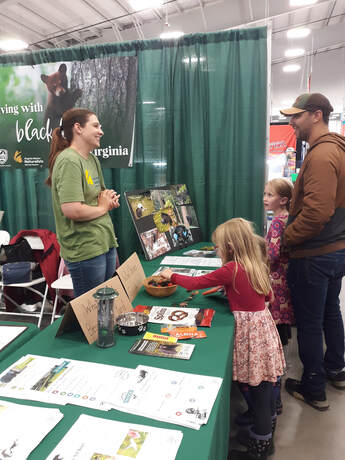
VMN volunteer sharing information on black bears with Virginia State Fair visitors. Photo contributed by Becky Kyle.
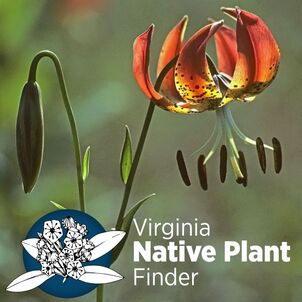 Turk’s cap lily (Lilium superbum). Image courtesy of VDCR
Turk’s cap lily (Lilium superbum). Image courtesy of VDCR 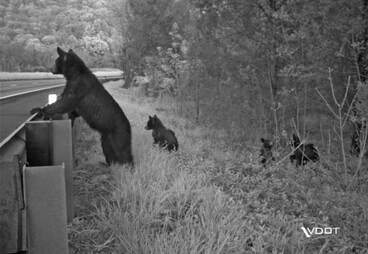 Image courtesy of Virginia Transportation Research Council/VDOT
Image courtesy of Virginia Transportation Research Council/VDOT 
